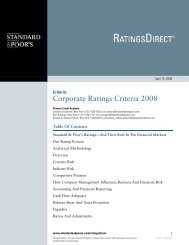European Infrastructure Finance Yearbook - Investing In Bonds ...
European Infrastructure Finance Yearbook - Investing In Bonds ...
European Infrastructure Finance Yearbook - Investing In Bonds ...
Create successful ePaper yourself
Turn your PDF publications into a flip-book with our unique Google optimized e-Paper software.
project economics and expected revenue<br />
growth are known. Unless revenue and<br />
EBITDA growth is at least equal to the<br />
proportion of debt accretion, DSCRs will<br />
narrow and the enterprise value of the<br />
project will decline.<br />
• Greater reliance on growth. Accreting debt<br />
structures cause an overstatement of DSCRs<br />
in the early years of a concession (by the<br />
amount of the interest accrual or swap<br />
inflow to the project). This allows early-year<br />
cash flow deficiency to be managed (relative<br />
to expected net revenue) while maintaining<br />
dividend payments. Moreover, to the extent<br />
the revenue, EBITDA, operating, and capital<br />
cost and refinancing assumptions are<br />
aggressive, as the accreting debt balance<br />
amortizes in the medium-to-long term, longterm<br />
DSCRs are at risk of not meeting base<br />
case projections.<br />
• <strong>In</strong>creased flexibility. Deferred-pay<br />
mechanisms and non-amortizing structures<br />
can inject flexibility into an infrastructure<br />
financing structure, especially under more<br />
aggressive revenue growth assumptions or<br />
during the project’s start-up phase.<br />
However, these deferability features<br />
introduce additional credit risks for senior<br />
lenders as debt increases.<br />
• Allocation of risk/reward altered. Significant<br />
dividend distributions remitted as a result of<br />
the accreting structure’s deferral of senior<br />
debt payments effectively puts equity ahead<br />
of debt in the payment structure. This is a<br />
reversal of the traditional role of capital<br />
structure priority and funds flow<br />
subordination, whereby equity acts as<br />
patient capital and a buffer for senior debt<br />
during periods of revenue ramp-up or<br />
project cash flow weakness and is not seen<br />
as earning a notable proportion of its<br />
projected return ahead of senior debt.<br />
Sponsors have advocated accreting debt<br />
structures by highlighting lengthy concession<br />
terms of many infrastructure transactions that<br />
provide ample time in later years to repay higher<br />
debt, although that same opportunity to earn cash<br />
flow returns later in the concession also applies to<br />
equity distributions. Nonetheless, combined with<br />
solid business positions and inflation-linked<br />
revenues streams, sponsors view the risk profile of<br />
STANDARD & POOR’S EUROPEAN INFRASTRUCTURE FINANCE YEARBOOK<br />
PROJECT FINANCE/PUBLIC-PRIVATE PARTNERSHIPS<br />
these assets as low.<br />
<strong>In</strong> many respects, long-term concessions can be<br />
viewed as corporate transactions (perpetual<br />
economic ownership of an asset). Generally,<br />
corporate entities debt-finance and refinance on<br />
an ongoing basis. For projects, we assume that<br />
finite debt is issued and repaid along the<br />
depreciating asset life. Also, the benefit of<br />
covenants in rating corporate type structures is<br />
less so than for projects. While the sponsor<br />
argument of more corporate style financing of<br />
very long-term concessions is reasonable, the<br />
rating challenge is that transaction participants<br />
cannot have both the benefit of undertaking a<br />
corporate-style financing but calling it a project<br />
financing by adding structural features that have<br />
less value in a corporate finance rating approach.<br />
To the extent that a good portion of equity<br />
returns in the early years of a concession is<br />
derived from excess cash flow that accreting debt<br />
or swap structures produce, rather than<br />
outperformance by the project, there are clear<br />
benefits and incentives for sponsors to promote<br />
financing structures that use accreting debt.<br />
Standard & Poor’s has observed financial models<br />
for infrastructure transactions in which aggressive<br />
growth assumptions for revenue, together with<br />
the cash flow benefits of using accreting debt (or<br />
accreting swaps), results in the original paid-in<br />
equity capital being returned to sponsors before<br />
any debt repayment occurs. This has appeal to<br />
project sponsors but a fundamental credit issue is<br />
how the shift in risk to long-term lenders and<br />
the enhanced returns to equity sponsors affect<br />
credit quality.<br />
Equity risk premiums (the difference between a<br />
project’s cost of debt and its expected equity<br />
return) can provide a quantitative proxy for the<br />
relative risk of an entity. The equity risk<br />
premiums observed for accreting debt structures<br />
in infrastructure financings have been as high as<br />
8%-12% (800-1,200 basis points). This reflects<br />
only pretax cash equity yields and excludes<br />
additional equity return benefit that might be<br />
earned by sponsors through tax deductibility of<br />
interest expense and amortization items (capital<br />
cost allowance deductions or amortization of<br />
goodwill) should economic ownership and tax<br />
benefits be conferred to the concessionaire due to<br />
the concession’s lengthy term. <strong>In</strong> contrast,<br />
regulated utilities, which we rate slightly higher<br />
than low investment-grade infrastructure projects<br />
NOVEMBER 2007 ■ 109



